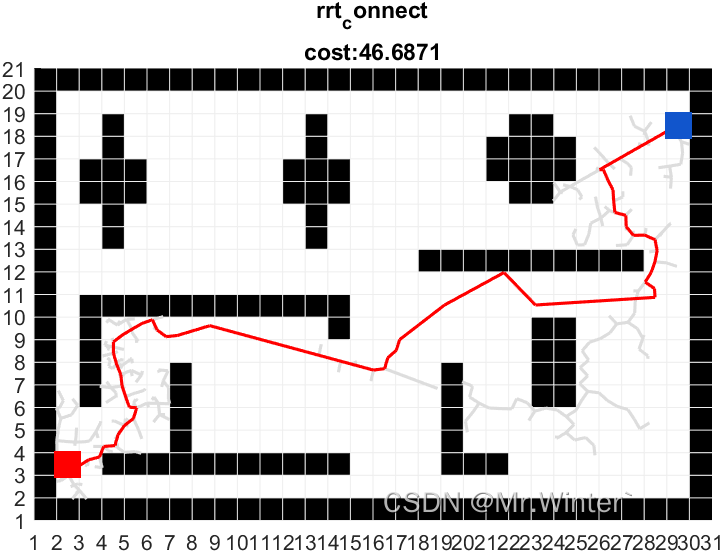您现在的位置是:首页 >其他 >路径规划 | 图解RRT-Connect算法(附ROS C++/Python/Matlab仿真)网站首页其他
路径规划 | 图解RRT-Connect算法(附ROS C++/Python/Matlab仿真)
简介路径规划 | 图解RRT-Connect算法(附ROS C++/Python/Matlab仿真)
0 专栏介绍
?附C++/Python/Matlab全套代码?课程设计、毕业设计、创新竞赛必备!详细介绍全局规划(图搜索、采样法、智能算法等);局部规划(DWA、APF等);曲线优化(贝塞尔曲线、B样条曲线等)。
?详情:图解自动驾驶中的运动规划(Motion Planning),附几十种规划算法
1 RRT-Connect基本原理
在原始RRT算法中,终点附近的区域信息并不能得到有效利用,为了解决这个问题,可以分别以起点和终点为根节点进行双搜索树双向扩展,当两棵树建立连接时可回溯可行路径,称为RRT-Connect算法


2 RRT-Connect vs. RRT
对原始版本RRT算法不了解的同学请看:路径规划 | 图解快速随机扩展树RRT算法(附ROS C++/Python/Matlab仿真)。与RRT算法相比,RRT-Connect有什么特别的优势呢?
- 更高效的路径搜索:RRT-Connect算法通过引入Connect启发式算法,将传统的扩张函数替换为一种贪婪策略——允许在更长的距离上移动,而不仅限于单步扩展,从而在探索可行路径时具有更高的效率。这使得RRT-Connect能够更快地收敛到可行路径,尤其是在没有微分约束的情况下。
- 更好的全局规划性能:RRT-Connect算法的另一个优点是它能够同时从起始配置和目标配置开始扩展RRT。这种双向扩展可以更好地探索搜索空间,并在找到可行路径时更快地连接起始配置和目标配置。这使得RRT-Connect算法在全局路径规划方面更为有效,并且具有更好的搜索性能。
RRT-Connect算法流程如下所示

3 ROS C++算法实现
核心代码如下所示
bool RRTConnect::plan(const unsigned char* gloal_costmap, const Node& start, const Node& goal, std::vector<Node>& path,
std::vector<Node>& expand)
{
sample_list_f_.clear();
sample_list_b_.clear();
// copy
start_ = start, goal_ = goal;
costs_ = gloal_costmap;
sample_list_f_.insert(start);
sample_list_b_.insert(goal);
expand.push_back(start);
expand.push_back(goal);
// main loop
int iteration = 0;
while (iteration < sample_num_)
{
// generate a random node in the map
Node sample_node = _generateRandomNode();
// obstacle
if (gloal_costmap[sample_node.id_] >= lethal_cost_ * factor_)
continue;
// visited
if (sample_list_.find(sample_node) != sample_list_.end())
continue;
// regular the sample node
Node new_node = _findNearestPoint(sample_list_f_, sample_node);
if (new_node.id_ == -1)
continue;
else
{
sample_list_f_.insert(new_node);
expand.push_back(new_node);
// backward exploring
Node new_node_b = _findNearestPoint(sample_list_b_, new_node);
if (new_node_b.id_ != -1)
{
sample_list_b_.insert(new_node_b);
expand.push_back(new_node_b);
// greedy extending
while (true)
{
double dist = std::min(max_dist_, _dist(new_node, new_node_b));
double theta = _angle(new_node_b, new_node);
Node new_node_b2;
new_node_b2.x_ = new_node_b.x_ + (int)(dist * cos(theta));
new_node_b2.y_ = new_node_b.y_ + (int)(dist * sin(theta));
new_node_b2.id_ = grid2Index(new_node_b2.x_, new_node_b2.y_);
new_node_b2.pid_ = new_node_b.id_;
new_node_b2.g_ = dist + new_node_b.g_;
if (!_isAnyObstacleInPath(new_node_b, new_node_b2))
{
sample_list_b_.insert(new_node_b2);
expand.push_back(new_node_b2);
new_node_b = new_node_b2;
}
else
break;
// connected -> goal found
if (new_node_b == new_node)
{
path = _convertClosedListToPath(new_node_b);
return true;
}
}
}
}
// swap
if (sample_list_b_.size() < sample_list_f_.size())
std::swap(sample_list_f_, sample_list_b_);
iteration++;
}
return false;
}
运行效果图

4 Python算法实现
核心代码如下所示
def plan(self):
for _ in range(self.sample_num):
# generate a random node in the map
node_rand = self.generateRandomNode()
# generate new node
node_new = self.getNearest(self.sample_list_f, node_rand)
if node_new:
self.sample_list_f.append(node_new)
# backward exploring
node_new_b = self.getNearest(self.sample_list_b, node_new)
if node_new_b:
self.sample_list_b.append(node_new_b)
# greedy extending
while True:
dist = min(self.max_dist, self.dist(node_new, node_new_b))
theta = self.angle(node_new_b, node_new)
node_new_b2 = Node((node_new_b.current[0] + dist * math.cos(theta),
(node_new_b.current[1] + dist * math.sin(theta))),
node_new_b.current, node_new_b.g + dist, 0)
if not self.isCollision(node_new_b2, node_new_b):
self.sample_list_b.append(node_new_b2)
node_new_b = node_new_b2
else:
break
if node_new_b == node_new:
return self.extractPath(node_new)
if len(self.sample_list_b) < len(self.sample_list_f):
self.sample_list_f, self.sample_list_b = self.sample_list_b, self.sample_list_f
return 0, None

5 Matlab算法实现
核心代码如下所示
% main loop
for i=1: param.sample_num
% generate a random node in the map
node_rand = generate_node(goal, param);
% generate new node
[node_new, success] = get_nearest(sample_list_f, node_rand, map, param);
if success
sample_list_f = [node_new; sample_list_f];
% backward exploring
[node_new_b, success_b] = get_nearest(sample_list_b, node_new(1:2), map, param);
if success_b
sample_list_b = [node_new_b; sample_list_b];
% greedy extending
while true
distance = min(param.max_dist, dist(node_new(1:2), node_new_b(1:2)'));
theta = angle(node_new_b, node_new);
node_new_b2 = [node_new_b(1) + distance * cos(theta), ...
node_new_b(2) + distance * sin(theta), ...
node_new_b(3) + distance, ...
node_new_b(1:2)];
if ~is_collision(node_new_b2(1:2), node_new_b(1:2), map, param)
sample_list_b = [node_new_b2; sample_list_b];
node_new_b = node_new_b2;
else
break
end
% goal found
if node_new_b(1) == node_new(1) && node_new_b(2) == node_new(2)
flag = true;
cost = sample_list_f(1, 3) + sample_list_b(1, 3);
path = extract_path(sample_list_f, sample_list_b, start, goal);
expand = [sample_list_f; sample_list_b];
return
end
end
end
end
[len_f, ~] = size(sample_list_f); [len_b, ~] = size(sample_list_b);
if len_b < len_f
temp = sample_list_f;
sample_list_f = sample_list_b;
sample_list_b = temp;
end
end

完整工程代码请联系下方博主名片获取
? 更多精彩专栏:
风语者!平时喜欢研究各种技术,目前在从事后端开发工作,热爱生活、热爱工作。






 U8W/U8W-Mini使用与常见问题解决
U8W/U8W-Mini使用与常见问题解决 QT多线程的5种用法,通过使用线程解决UI主界面的耗时操作代码,防止界面卡死。...
QT多线程的5种用法,通过使用线程解决UI主界面的耗时操作代码,防止界面卡死。... stm32使用HAL库配置串口中断收发数据(保姆级教程)
stm32使用HAL库配置串口中断收发数据(保姆级教程) 分享几个国内免费的ChatGPT镜像网址(亲测有效)
分享几个国内免费的ChatGPT镜像网址(亲测有效) Allegro16.6差分等长设置及走线总结
Allegro16.6差分等长设置及走线总结